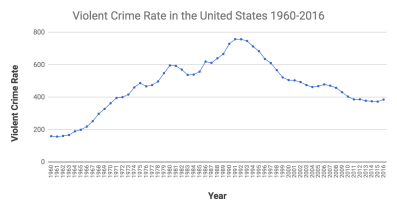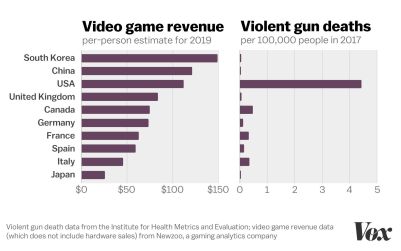With the recent mass shootings there has been a lot of talk about violent video games and their potential role in causing violent crime. In this video I break down the data and find out whether this link is real, or just rhetoric.


The following article is a reproduction, and has been modified for this site. The original article, and many more, can be found at RemptonGames.com
Hey everybody! As you can see from the title, today�’s topic is a bit different. Instead of talking about game design, I want to take a look at a major issue that has been surrounding the video game industry for a while now, and that is the supposed connection between Video Games and Violence, specifically mass shootings in America.
This idea is not a new one, but the debate around violent video games has sparked up again in earnest due to the recent mass shootings in El Paso, Texas and Dayton, Ohio. Specifically, President Trump himself has made statements about these shootings, and suggested that video games that “celebrate violence” could be part of the problem.

Pictured: Somebody who would never celebrate violence
This is not the first time politicians have made statements regarding Video Games, and it is not the first time there has been proposals to limit or restrict video games. While these measures have not been rejected by the courts in the past, this does not mean that we can just sit back and hope that nothing happens to restrict or censor the creative freedom of this industry.
This is a very divisive issue, with strong beliefs on both sides, and like any divisive issue it can be difficult to convince anybody to relinquish their firmly held beliefs. I also believe that, on many divisive issues, two reasonable people can be presented with the same body of evidence and come to different conclusions based on their own values and priorities.
I do not believe this is one of those issues. This is an issue, much like the roundness of the earth and the efficacy of vaccines, where the evidence is strongly and convincingly on one side of the scale. For that reason, the goal of this video is to present this evidence in as unbiased a way as I am capable. My goal is not to shame or criticize those who believe that video games cause violence, because I believe that many of them have good intentions. I simply believe that they are misinformed, and I hope that by trying to present a complete picture I can show that their fears are unfounded.
However, I don’t want this video to just be preaching to the choir. If you are watching this on my blog then odds are you are already a fan of video games, and probably already know that they don’t cause violence. However, if you have a friend, relative, or elected official that feels differently, please share this video with them. I believe that this is an important issue, and if anything I have ever made deserves to blow up I hope it would be this video.
History of Moral Panics
The idea that the act of playing a violent video game can make somebody commit violent crimes, is not new. In fact, this idea has been around since at least 1976, with the release of the game Death Race. In this game players drive a tiny pixelated car around a black screen, and try to run over small humanoid “gremlins”. While this game may seem quite primitive to our modern eyes, it created quite a backlash at the time. In an article in the Spokane Washington Spokesman from the time, Dr. Gerald Driessen was quoted as calling the game “Gross”, and saying that “I shudder to think of what is next if this one is not defeated by public opinion”. In the same article an automobile safety consultant said that “the safety council teaches drivers how to avoid pedestrians. And now this morbid game comes along and encourages people to develop the opposite skill – how to hit people.

The horror!
The backlash over video games has only continued since then, with controversy over games such as Mortal Kombat and Grand Theft Auto receiving a lot of media attention. However, video games are far from the first or only medium to have sparked these sorts of moral panics. You may be familiar with some of the more famous moral panics, such as the Satanic Panic that surrounded Dungeons and Dragons or the controversy around comic books that was responsible for the creation of the Comics Code Authority. However, the history of moral panics goes much deeper than that.
Here is a brief list of things that have been responsible for moral panics in the past: Pinball machines, Harry Potter, Women riding bicycles, and Sofas. The Waltz was considered obscene, Furbys were banned by the NSA, and nude statues had to be covered up with fig leaves. Pope Gregory XVI (the sixteenth) even banned street lights and railroads in all papal states in the 1830s.
What do all of these things have in common? They were new, and therefore not well understood. When these things were first released they represented the unknown, and the mysterious. However, these days none of these would be considered dangerous. As they spread and became better understood people become more accepting of them and the controversies died down.
However, the controversy around video games has now been around for over 40 years and still hasn’t gone away. What makes video games different? The key difference is actually the core of what makes Video Games unique as an art form – interactivity. When a player is playing a video game they are not just viewing or reading about a particular action – they are actually responsible for what they character does on screen. When an on-screen character shoots another player in a battle royale game, they are the ones pulling the trigger. Surely, the argument goes, this sort of interactive violence would spill over into real life?

I can hardly count the number of hand injuries I have gotten from punching trees
While this argument may make some intuitive sense, it simply isn’t supported by the data (which we will get to soon, don’t worry). However, before I look at the data I want to address two key points about this argument.
First, I want to look at the fundamental assumption that this argument makes, which is that gamers cannot, or have difficulty, separating the fantasy of a video game world from the reality of the real world. If you’ve played a game for a few hours it is entirely possible that the game will linger in your mind. Your fingers might twitch to press a button even when you aren’t holding a controller, or you might subconsciously be planning strategies for the next time you pick the game up. You might even think about how the game mechanics would work in real life, such as picturing guitar hero notes when you hear a song.
This phenomenon is known as Game Transfer Phenomena, and many articles have been written about it claiming that gamers are losing their grip on reality. However, this interpretation of the data is sensationalist and completely overblown. While small details from a game might get stuck in a player’s head, it is no different from when you get a song stuck in your head or wish you could use the force from Star Wars to grab the tv remote. Even when fully immersed in virtual reality, players are still always conscious of what is real and what is not. If somebody does have difficulty distinguishing the fantasy of a video game from the real world, it is likely due to an underlying issue that is entirely separate from their game playing.
The second point is the claim that video games are glorifying or celebrating violence. The fact is, media has been glorifying violence since the dawn of mankind, but anytime a new form of media comes out we all seem to forget about the past. Some of the oldest tales that have been passed down throughout history are tales of ancient heroes defeating monsters, slaying their enemies, and winning wars. Board games depicting war and violence have been around for centuries, and violent novels, radio plays, films, comic books, and television shows have been around for decades.
Even in the bible itself we have the destruction of Jericho, the conquest of Canaan, David vs Goliath, Elisha commanding bears to attack a bunch of people that mocked him, and Samson defeating an entire army of Philistines using the jawbone of a donkey, among many, many others. All of these instances are clear examples of glorification of violence, and yet do not get nearly the same amount of backlash as violent video games.

Who uses a jawbone? Honestly….
Video Games are an incredibly broad category
One problem with this backlash against video games is that it can be seen as painting the entire medium with a very broad brush. Among anti-video game advocates there seems to be a conception that all video games are simply high-tech murder simulators, but this could not be further from the truth. Video games are an incredibly broad art form that is capable of teaching new skills, telling stories, immersing players in inventive worlds, and so much more.
For many, video games are an outlet for creativity. Simply take a look at the list of top selling video games of all time. The number 1 game on there, selling 176 million copies, is Minecraft. Minecraft is a game purely about creativity and exploration, and is not only used by many to create amazing works of art, but has also been used as a tool to educate children. The second highest selling game on the list is Tetris, a harmless puzzle game. Grand Theft Auto 5, the first violent video game on the list, is a distant third that trails by over 60 million units.

No matter what I do in life, I will never be this impressive
Games represent far more than violent actions. They represent puzzles, racing, sports, adventure, building, rhythm, and so much more.
The Data Behind Violent video games
As we all know, correlation does not imply causation. This means that, even if the data shows two things to be related to one another it doesn’t mean that one causes the other. There could be a third factor that causes both of them, or it could be a coincidence. On the other hand, if there is a causal connection between two events then we should be able to see a correlation between them in the data. However, if you look at the data around video games and violence you will see that there is clearly no correlation.
The first type of correlation you could try to look for is temporal. In theory, if video games caused violent acts then as more people began playing video games you should also see more violent acts. However, this doesn’t hold up.
The following chart, from Bloomburg.com, shows the annual revenue of the video game industry over nearly 50 years, from 1970 to 2018. As you can see, during this time the video game industry has exploded, growing nearly every year and reaching nearly $150 billion in annual sales. Not only that, but games have also gotten much more realistic during that time, and you would assume that the more realistic a video game looks the more likely it would be to drive a person to actual violence. With this powerfully combination of factors, surely violent crime has skyrocketed over the past few decades?

Fortunately for the world, but unfortunately for this argument, the data actually shows the exact opposite. In this graph, which shows the violent crime rate in the United States from 1960 to 2016, you can see that violent crime has actually been declining since the early 90’s. While the video game market has nearly tripled since then, there has not been a corresponding increase in violent crime.

However, trends like these can be quite difficult to track over time. So much has changed in the last 50 years that it can be difficult to isolate the effects of video games on these statistics. There are a million different factors that affect the violent crime rate, and based solely upon this evidence it is entirely possible that violent video games are linked to an increase in violence, but other factors have provided a powerful enough decrease to counteract this effect. Clearly these graphs do not show a correlation, but we should keep digging.
Perhaps there is a geographic correlation instead. If video games cause violence, it might be reasonable to assume that countries with higher rates of playing video games would also have higher rates of violence. However, the data also does not bear this out. This chart from Vox takes a look at the top 10 countries around the world in terms of average video game spending per-person, and compares that to each country’s violent gun deaths. What it shows is that there is no clear connection between playing video games and violent actions across these various countries.

But wait! You may be saying. It is not a fair comparison to directly relate different countries to one another. There can be countless differences between different countries, from their culture to their political landscapes, that could account for this lack of correlation. For example, some countries believe that owning guns is a fundamental human right that should not be restricted in any way, whereas other countries are not the United States. And I would say that, once again, you are right. Wow, my job would sure be a lot easier if I just came up with a dumber strawman, wouldn’t it?

I’m here if you need me…
So far we have found no evidence of a link between video games and violence over time, nor have we found a link across different countries. However, these are just statistics and, as we well know, statistics can be misleading. I think it’s time to break out the big guns – peer reviewed, controlled scientific trials. Hopefully these studies will be able to show, on an individual level, what effect (if any) violent video games have on a person’s behavior.
Here is also where things get a bit murky, because over the past decades there have been countless studies in this area. These studies may use different methodologies, with different sample groups, and measure their results in different ways. For this reason, I don’t think that simply citing a study or two that show no correlation between video games and violence would be very convincing, because it is entirely possible to present a counter-example that does seem to show a link. Instead, what I would like to do is show the broad consensus of studies, and try to explain the major outliers.
How do you show consensus among dozens of studies? With a meta-analysis, of course! By taking groups of studies on the same topic, meta-analyses can try to minimize the error and bias of any individual study, and reach a more general solution. This seems like the perfect thing to finally put this issue to bed.
There have been a few different meta-analyses of this issue, analyzing hundreds of different studies and compiling the results. The findings? Playing violent video games has been found to have a positive correlation with aggressive behaviors in a lab! Well, I guess I was wrong, better pack up and leave, and not dig any deeper into this. After all, why would I ever read past a headline? It already says everything I need to know!
A great example of this is the study entitled “Metaanalysis of the relationship between violent video game play and physical aggression over time”, written by Anna T. Prescott, James D. Sargent, and Jay G. Hull. This study had the purported goal of being a meta-analysis of video game violence studies which linked video games to “overt physical aggression”.
To do so, this meta-analysis chose 24 studies that only studied the effects of violent games (as opposed to video games in general) and which connected these games to aggressive behavior, rather than simply aggressive thoughts and feelings. When all was said and done, this study found a positive correlation between playing violent video games and “overt aggressive behavior”.
If it seems pretty cut and dry, it’s not. First, we need to look at the size of the effect that was found. This study found that playing violent video games has less than a 1% correlation with an increase in aggressive behavior. Second, is the way that this study measures and defines “aggressive behavior”. Many of the studies included in this analysis included self-reported data, or aggressiveness was measures by asking players to respond to various survey questions.
Not only is self-reported data notoriously unreliable, but according to Psychology Today the types of behaviors that were considered to be “overt aggression” included statements such as “I have become so mad that I have broken things” and “If I have to resort to violence to protect my rights, I will.” These studies may also have been victim to priming bias – if you ask a person about their experiences playing violent video games, this could put them in a frame of mind that would color their responses to the questions that follow.
Other studies associated video games with signifiers of aggression such as raised heart rate and levels of adrenaline which…duh? I probably have higher heart rate and adrenaline after an intense round of Guitar Hero, but that doesn’t mean I’m going to commit a violent crime. It just means that I was immersed in the moment and caught up in the rush of an enjoyable experience.

People still play Guitar Hero….right?
Keep in mind that what these studies are measuring is signifiers of aggression, not actual violence. What happens if you actually measure the relationship between playing violent video games and real-world violent acts? It turns out that you actually find that violent video games have a negative correlation with real-world acts of violent crime.
A 2014 study from the American Psychological Association measured various variables over time, including the release dates of violent video games, violent video game sales data, online searches for violent video games, and real-world violent crimes such as homicides and assaults. In this study, they actually found that increases in violent video game activity (more releases, sales, and online searches) was actually correlated with a decrease in real-world violent crimes.
Another study from 2010 analyzed violent crime rates among neighborhoods with different numbers of video game stores. This study showed that there was a clear link between neighborhoods with more video game stores and fewer violent crimes, even when controlling for factors such as income, unemployment, population, and police activity.
How can this be? The most common hypothesis is simply that if somebody is inside playing a video game they cannot also be committing a violent crime. Video games can be a very time-consuming hobby, and it turns out most people would rather play Assassin’s Creed than, you know, actually assassinate somebody.
The Myth of the “Gamer” – Everybody Plays Games Now!
Even after all of this, you may still be shouting at the screen – “If violent video games don’t cause violence, then why do so many school shooters play violent games”! The honest answer is that games are just incredibly popular. Video games are so popular now that saying that somebody plays video games is kinda similar to saying that you eat at McDonalds – some people might shame you for it, but pretty much everybody does it.
Statistically, around 60% of Americans from all walks of life report playing video games daily. The free Battle Royale game Fortnite has around 250 million registered users, and at its peak reported 76 million users in a single month. The video game industry is now the largest media industry on the planet, making more money than Music, Film or Television. Video gaming is huge, and simply saying that somebody plays video games doesn’t really say much about that person anymore.
Why Blaming Video Games is Harmful
Nations that play games more don’t have more shooting deaths, violent crime has gone down over the same period of time that video games have exploded in popularity, neighborhoods with more game stores have fewer violent crimes (even after controlling for various factors), crime tends to go down when new games are released, and even with their best efforts to link video games to aggression scientists were only able to find a 1% link. With all of this evidence, I believe it is pretty clear that video games are not responsible for violent crimes or mass shootings in the united states.
However, I believe this problem actually goes even further. Blaming video games for violent crime is not just inaccurate, but actually quite harmful. I believe that, in many cases, video games are being used as a scapegoat to avoid having to deal with any of the real issues that are responsible for violent crime in America. As long as politicians and the media are focusing on video games, they are not focusing on the changes and reforms that might actually make a difference.
Another reason why blaming video games for violent crimes is harmful is because playing video games can actually be incredibly beneficial in many ways. While I don’t have time to get into all of the details, video games can be incredibly useful for education and provide a number of physical and cognitive benefits such as improved dexterity and spatial reasoning, which you can read about in these previous articles. Because of the numerous benefits that video games can provide to those who play them, I think it would be such a shame for this wonderful medium to be banned or restricted due to misplaced and unsupported ideas about causing violent crime.
Until Next Time!
That is all I have for this week. If you enjoyed this article, check out the rest of the blog and subscribe on Twitter, Youtube, or here on WordPress so you will always know when I post a new article. If you didn’t, let me know what I can do better in the comments down below. And join me in two weeks, when I will look at what would actually happen if Magic: The Gathering added a sixth color!
Read more about:
BlogsAbout the Author(s)
You May Also Like








